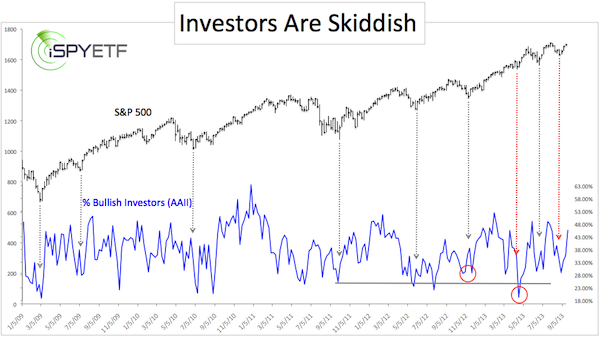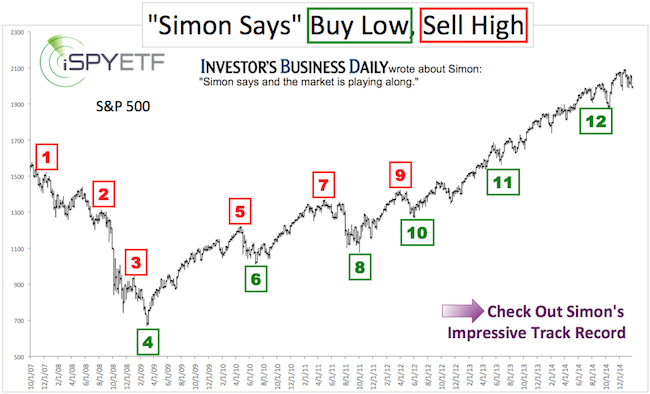A watched pot never boils. Perhaps that’s why this QE bull market keeps on going. The QE bull slogan could go something like this: ‘A mistrusted market never tops.’
Everyone and their grandma know that Fed liquidity is the driving force behind stocks. And everyone and their grandma know that stocks will give back their gains once the gig is over.
A close look at sentiment readings shows that – every time stocks decline a bit – investors think: ‘That's it, the gig is over.’
In June the VIX (Chicago Options: ^VIX) jumped 78% as the S&P 500 (SNP: ^GSPC) declined 7.5%. In February the VIX soared 56% in four days while the S&P 500 (NYSEArca: SPY) notched down a measly 3%.
The chart below plots the S&P 500 (NYSEArca: IVV) against the percentage of bullish retail investors polled by the American Association for Individual Investors (AAII).
A 3.8% correction in April sent the percentage of bullish investors to the lowest reading since the March 2009 bottom (red arrow). The 4.8% correction in August had the same effect on investors as normally has a 10% correction.

The March 2013 Sentiment Picture (a detailed monthly analysis of various sentiment gauges published by the Profit Radar Report) commented on the finicky nature of investors and stated that: “The propensity for investors to turn instantly bearish is likely to keep sell offs contained in the foreseeable future.”
If you enjoy quality, hand-crafted research, >> Sign up for the FREE iSPYETF Newsletter
What A Finicky Investor Means for Stocks
Sentiment is a contrarian indicator and bearish sentiment extremes are bullish for stocks. When investors are bearish, they likely have already sold their positions. This means there are fewer investors left to sell stocks and drive prices much lower.
Investors turning bearish much faster means that it took a lot of sellers to drive prices down just a little bit. Based on the above chart it can be argued that brief spurts of retail selling overpower commercial selling.
The commercial buying spree, which is sponsored by the Fed’s QE, continues when retail selling is exhausted.
What Can Kill this QE Fat Bull
It will probably take one of the three conditions below to lead to a sustained decline:
1) Extreme optimism
2) Panic selling
3) Technical breakdown
Of course sentiment will be a somewhat lagging indicator.
We will turn to technical analysis for more real-time buy/sell signals. As the old saying says: ‘An ounce of prevention is worth more than a pound of cure.’
Most major indexes are at a major inflection (or make it or break it) point right now. The next few days will provide valuable clues about the market action for weeks to come.
Simon Maierhofer is the publisher of the Profit Radar Report. The Profit Radar Report presents complex market analysis (S&P 500, Dow Jones, gold, silver, euro and bonds) in an easy format. Technical analysis, sentiment indicators, seasonal patterns and common sense are all wrapped up into two or more easy-to-read weekly updates. All Profit Radar Report recommendations resulted in a 59.51% net gain in 2013 and 17.59% in 2014.
Follow Simon on Twitter @ iSPYETF or sign up for the FREE iSPYETF Newsletter to get actionable ETF trade ideas delivered for free.

|